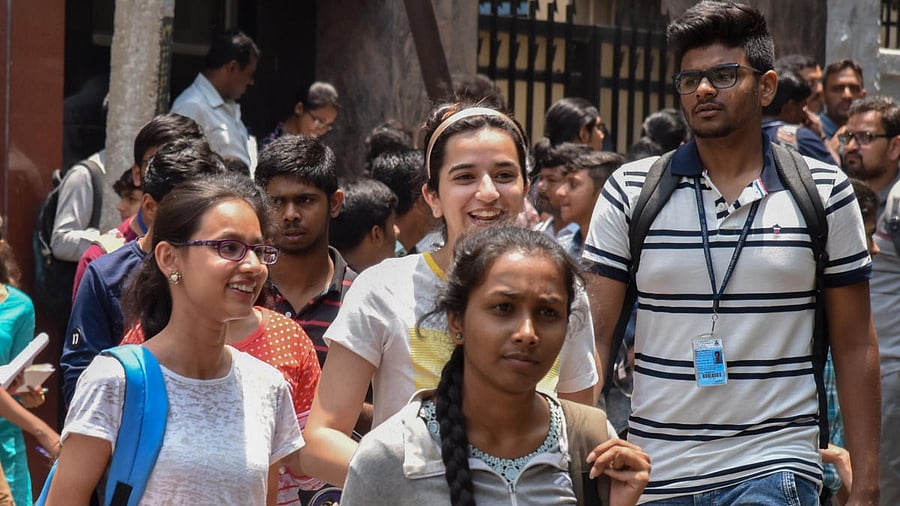
College students in Karnataka. (Image for representation)
DH Photo
By Dayakar Peddi and Anushi Tiwary
In the grand tapestry of human development, education remains a way of empowerment and progress. It is not merely a means to economic growth but a fundamental pillar of social justice, individual freedom and collective well-being. Yet, in India — a nation teeming with youthful energy and aspirations — the state of higher education presents a paradox. While the country has made strides in expanding access to primary education, its investment in higher education, particularly in research, remains woefully inadequate, especially in comparison to nations with similar socio-economic profiles.
To understand India’s position, it is instructive to examine countries with comparable socio-economic indicators, such as Brazil, South Africa, Indonesia, Mexico, Thailand, Vietnam, Egypt, Turkey, Malaysia and the Philippines. Like India, these nations are classified as middle-income economies with significant youth populations and aspirations for rapid development. Yet, their investment in higher education tells a story of stronger commitment. According to Unesco’s Institute for Statistics (UIS), these countries spend, on average, between 0.8% and 1.5% of their GDP on higher education.
In stark contrast, India spends a mere 0.6% of its GDP on higher education. This disparity is not just a matter of numbers but a reflection of deeper systemic issues. It raises questions about India’s commitment to fostering a knowledge-based economy and its ability to utilise the potential of its demographic dividend. It tells a story of stagnation, erratic funding and missed opportunities. While there has been a nominal increase in absolute terms, spending as a percentage of GDP has remained gravely deficient at around 0.6%, far below the global average of 1%.
Higher education is not merely a line item in a national budget; it reflects a society’s commitment to its future. However, it has historically been a low priority. While sectors like defence, infrastructure and subsidies receive significant allocations, education — particularly higher education — is often sidelined. Perhaps it reflects a lack of political will to invest in long-term human capital development. On top of that, fiscal constraints, exacerbated by the Covid-19 pandemic and competing priorities such as healthcare, social welfare and economic stimulus packages, have diverted resources away.
According to the NSSO 75th Social Consumption-Education Round (2017-18), the increased reliance on private funding has resulted in significant out-of-pocket expenditure by households, with the average share of higher education expenses accounting for 15.3% of total household expenditure in rural areas and 18.4% in urban areas among households participating in higher education.
Education, being on the concurrent list of the Indian Constitution, bears the brunt of a lack of coordination and inadequate central funding, forcing states to shoulder a disproportionate burden, often at the expense of other critical sectors. While initiatives like the Rashtriya Uchchatar Shiksha Abhiyan (RUSA) and the National Education Policy (NEP) have focused on expanding access to higher education, there has been insufficient investment in improving quality. Stagnant spending has led to overcrowded classrooms, outdated curricula and inadequate infrastructure.
State universities, which cater to the majority of students, have been chronically underfunded. Meanwhile, the rise of elite institutions like the IITs and IIMs has deepened regional disparities, creating a two-tiered system that entrenches social and economic inequalities. According to a World Bank report (2021), only a small fraction of Indian universities meet global standards for quality and research output. India’s total research and development (R&D) spending is a mere 0.7% of GDP, far below the global average of
1.8%. This has limited the country’s ability to innovate and compete in the global knowledge economy.
The current scenario places India far from achieving Sustainable Development Goal 4 (SDG 4), which calls for inclusive and equitable quality education and lifelong learning opportunities for all. The neglect is symptomatic of a deeper malaise: the prioritisation of short-term economic gains over long-term human development. Yet, there is hope. Higher education is not a luxury but a critical driver of innovation, critical thinking and social mobility. The solution lies in reimagining it as a public good and a collective responsibility, and by reorienting priorities to ensure it serves as a tool for empowerment rather than exclusion. It demands a commitment to expanding access, improving quality and fostering an environment where intellectual curiosity and critical inquiry can thrive. Only then can India hope to bridge the gap between its aspirations and realities and move closer to achieving the promise of SDG.
(Dayakar is an assistant professor at Agro Economic Research Centre and Anushi is a doctoral scholar at Gokhale Institute of Politics and Economics, Pune)
Disclaimer: The views expressed above are the author's own. They do not necessarily reflect the views of DH.